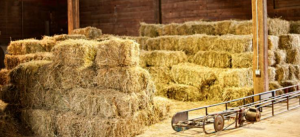 Feeding Low-Carbohydrate Hay or Straw to Obese Horses: The excess weight carried by obese horses may be an indication of an “easy keeper” metabolism. As a result, the heavy load can eventually take a toll on weight-bearing joints. In other cases, the bulging fat pads and cresty neck could be signs of metabolic diseases that put the obese horse at increased risk for laminitis. Either way, owners of overweight horses are often advised to work toward weight loss in their equines. This usually involves increasing the horse’s exercise level, eliminating grain, restricting grazing time, and feeding a low-carbohydrate source of fiber.
Feeding Low-Carbohydrate Hay or Straw to Obese Horses: The excess weight carried by obese horses may be an indication of an “easy keeper” metabolism. As a result, the heavy load can eventually take a toll on weight-bearing joints. In other cases, the bulging fat pads and cresty neck could be signs of metabolic diseases that put the obese horse at increased risk for laminitis. Either way, owners of overweight horses are often advised to work toward weight loss in their equines. This usually involves increasing the horse’s exercise level, eliminating grain, restricting grazing time, and feeding a low-carbohydrate source of fiber.
In managing an obese horse, the owner faces a dilemma. If the horse is lame or out of shape, it’s hard to add enough exercise to make a difference. Cutting grain from the diet is fairly simple, and a drylot or grazing muzzle can help with restricting pasture intake. However, horses that spend hours with an empty stomach are prime candidates for gastric ulcers. As a result, they need to have something to nibble on a fairly constant basis. Finding a low-carbohydrate hay may not be easy.
Straw:
Some horse owners wonder if straw—the slippery, shiny stems of wheat, oats, and other cereal plants—might be the answer. After all, straw is usually used for bedding so it can’t be worth much in the way of nutrition, right?
Unfortunately, some straw, particularly if it contains many of the grain seed heads, can be as high in nonstructural carbohydrates as good-quality grass hay or even alfalfa hay. Though it contains a lot of lignin, the indigestible fiber that causes its shiny appearance, straw may also contain an appreciable amount of digestible starch and carbohydrates. The only way to know these levels is to have the straw analyzed for nutritional value. Above all, as any type of hay should be tested before feeding it to obese horses. It’s not enough to get a base level from one shipment of hay or straw, either. The next truckload you order will probably be from a different cutting or region. Therefore, it will have different nutritional values.
Impaction:
Even if it’s possible to find a low-carbohydrate straw, there’s another potential problem with feeding this form of roughage. Because of its high proportion of indigestible fiber, straw is more likely than hay to cause impaction, a condition in which ingested material stops moving through the digestive tract and forms a blockage. This is particularly common in winter. Horses may not drink enough water to keep the intestinal tissues lubricated and elastic. Impaction colic is more of a risk for horses on a diet of straw or any other type of tough, stemmy forage. Chopping the straw into short pieces before feeding it may help to avoid this problem. Especially for horses whose teeth are not in perfect condition for chewing.
Because it may provide a significant level of calories while presenting a hazard for choke or impaction, straw isn’t a great forage choice for most horses. It’s probably safer to find and feed a low-carbohydrate hay, soaking it before feeding to remove some water-soluble carbohydrates. Testing hay is relatively inexpensive and can support health in horses and peace of mind in their owners.
Article Sources: Kentucky Equine Research
